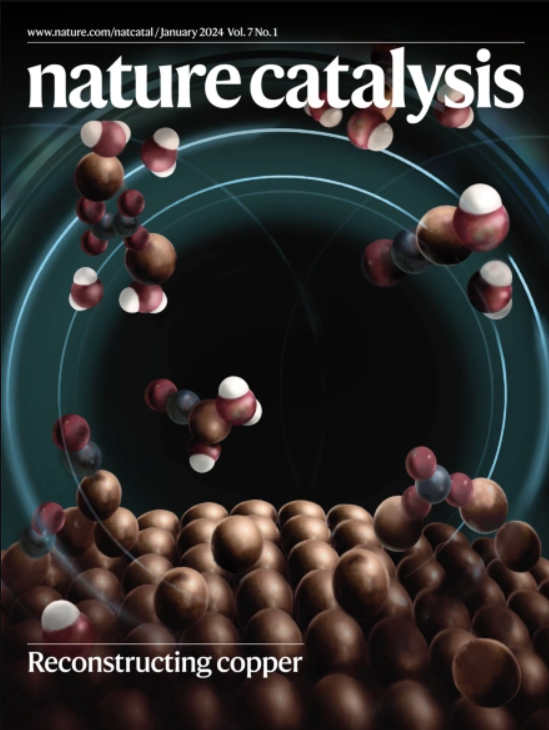Selective formaldehyde condensation on phosphorus-rich copper catalyst to produce liquid C3+ chemicals in electrocatalytic CO2 reduction
IF 44.6
1区 化学
Q1 CHEMISTRY, PHYSICAL
引用次数: 0
Abstract
Recent advancements in the CO2 reduction reaction (CO2RR) target multicarbon chemical production and scalable electrode designs for industrial applications. Here we introduce a zero-gap cell utilizing humidified gas-phase CO2 and circulated alkaline media, achieving a Faradaic efficiency of 66.9% for C3+ products and a current density of −1,100 mA cm−2. In situ spectroscopic analyses revealed formaldehyde as a key intermediate formed on copper oxide/hydroxide interfaces derived from a phosphorus-rich copper catalyst. Unlike conventional pathways based on dimerization of CO intermediates, our study selectively produces liquid-phase multicarbon products because of autonomous local pH variations under a weak alkaline microenvironment, with allyl alcohol as the dominant C3+ product. The high selectivity and efficiency for liquid products provide a substantial advantage for storage and transport, highlighting the scalability and practical feasibility of our approach, which offers a potential economically viable solution for CO2 utilization. This development encourages the adoption of CO2RR technologies in iron–steel and petrochemical industries to mitigate greenhouse gas emissions. Electrocatalytic CO2 reduction has largely been limited to C1 and C2 products, especially at high current densities. Here, a Faradaic efficiency of 67% is reported for C3+ products from CO2 at 1.1 A cm−2 via a formaldehyde condensation mechanism on a phosphorus-rich copper catalyst.


选择性甲醛在富磷铜催化剂上缩合生成液态C3+化学物电催化CO2还原
二氧化碳还原反应(CO2RR)的最新进展是针对工业应用的多碳化学生产和可扩展电极设计。在这里,我们介绍了一种利用加湿气相CO2和循环碱性介质的零间隙电池,C3+产品的法拉第效率为66.9%,电流密度为- 1,100 mA cm - 2。原位光谱分析表明,甲醛是富磷铜催化剂衍生的氧化铜/氢氧化物界面上形成的关键中间体。与基于CO中间体二聚化的传统途径不同,我们的研究选择性地产生液相多碳产物,因为在弱碱性微环境下,局部pH值会自主变化,丙烯醇是主要的C3+产物。液体产品的高选择性和高效率为储存和运输提供了巨大的优势,突出了我们方法的可扩展性和实际可行性,为二氧化碳利用提供了潜在的经济可行的解决方案。这一发展鼓励在钢铁和石化行业采用CO2RR技术,以减少温室气体排放。
本文章由计算机程序翻译,如有差异,请以英文原文为准。
求助全文
约1分钟内获得全文
求助全文
来源期刊

Nature Catalysis
Chemical Engineering-Bioengineering
CiteScore
52.10
自引率
1.10%
发文量
140
期刊介绍:
Nature Catalysis serves as a platform for researchers across chemistry and related fields, focusing on homogeneous catalysis, heterogeneous catalysis, and biocatalysts, encompassing both fundamental and applied studies. With a particular emphasis on advancing sustainable industries and processes, the journal provides comprehensive coverage of catalysis research, appealing to scientists, engineers, and researchers in academia and industry.
Maintaining the high standards of the Nature brand, Nature Catalysis boasts a dedicated team of professional editors, rigorous peer-review processes, and swift publication times, ensuring editorial independence and quality. The journal publishes work spanning heterogeneous catalysis, homogeneous catalysis, and biocatalysis, covering areas such as catalytic synthesis, mechanisms, characterization, computational studies, nanoparticle catalysis, electrocatalysis, photocatalysis, environmental catalysis, asymmetric catalysis, and various forms of organocatalysis.
 求助内容:
求助内容: 应助结果提醒方式:
应助结果提醒方式:


